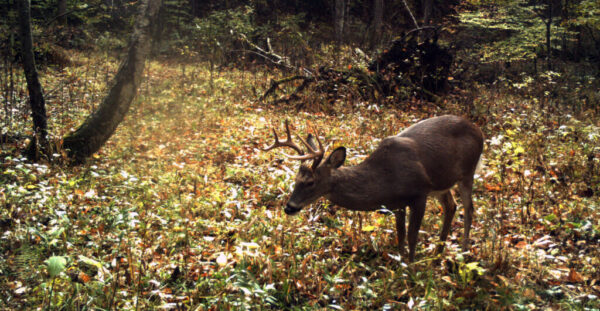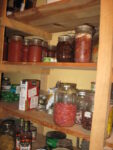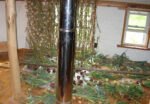
A version of this column first ran in the Roane County (WV) Reporter and Times Record. Support local journalism! Subscribe to your local newspaper. This is one of a series of blogs for new gardeners. Read the rest: Part 1. Part 2. Part 3.
Your garden has good soil, is freshly tilled and ready to grow many wheelbarrow loads of vegetables and perhaps some fruits (strawberries or raspberries). You have a plan. Next—you probably need a fence, to keep out the deer, groundhogs, rabbits, and the local dogs and cats (the dogs aren’t interested in your crops but may trample them; the cats look upon your soft earth with unseemly intent). So…how do you build this fence?
There are lots of possibilities, and your choice will reflect your budget and your primary enemies (e.g. for deer height is important but not size of holes). Just about any fence will be composed of posts and some sort of wire. For posts, your choice is wood or metal. Wood is a good choice if you have access to locust, which can last fifty years—but you probably need a post hole digger to set the posts. Metal fence posts can be bought locally in various lengths and pounded in. About eight feet apart is good. You need to plan for a gate of some kind, of course.
We bought cattle panels, which are 16 feet long, thus the eight foot spacing worked well. These are 52 inches tall, so we added extensions to the posts and ran a wire a foot above this, and another wire a foot above that. It isn’t electrified but maybe the deer don’t know that—in eleven years they’ve never gotten in. The cattle panels are more expensive than some options, but they’re such heavy gauge that they last decades—mine is only beginning to show rust. The wires are six inches apart both ways, so we used poultry netting over the panels…two-inch-mesh, which as it turned out doesn’t keep rabbits out. So I added a sixteen inch strip of one-inch-mesh netting at the bottom, and that works. A couple of other enclosures where I used only the netting have sagged badly and been invaded. The netting also rusts and frays, with loose wires catching on weed-eaters, lawnmowers, tillers, and my husband’s temper.
We have not had groundhog problems, thanks to Mocha (a pretty good dog). It has worked well to run Armacell mats under the fence, extending on both sides, and pin the bottom of the netting into the ground with garden staples (long U-shaped wire). The mats suppress weeds—the most troublesome are those growing under a fence. (Armacell has a facility in Spencer, WV where one can obtain seconds.)
May is here. Hopefully you already have your potatoes, peas, onions, spinach, radishes, lettuce, carrots, beets and chard planted, and you’ve set out the cabbage family seedlings you started back in March. If you can find (or order) strawberry plants, those can be set out any time, but you must pick off the flowers this year so they’ll fill their space with daughter plants. If you’re attentive to weeding and put them in good soil, you’ll get a lot of berries next year and the next.
What else can you plant next? Well, I consider our last frost date to be May 1st, so if it’s looking unlikely that we’ll get another frost, you can now plant almost anything. Beans, tomatoes, basil, corn, cucumbers, squash, melons, peppers…all of these can go in now but will be harmed, likely killed, if it frosts. You can cover plants and thus protect from a few degrees of frost, but you can’t cover a whole garden. A few things want it even warmer, sulking even in the forties…like sweet potatoes. A good compromise might be to plant one tender thing, say tomatoes, and cover them if it frosts…then if it doesn’t, plant another…until you’re very sure you’re past the risk.













